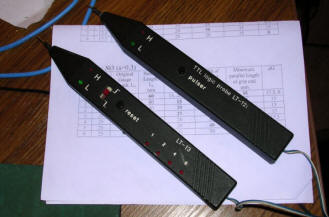Chapter 13: Mainboard
Usually the only part which can be tested when the computer is
powered on is video
output in typical resolution and keyboard, to test memory or I/O ports you need
to load specific software. Methods of loading software vary from computer to
computer, from simple EAR/MIC tape recorder sockets and CLOAD BASIC instruction
to proprietary tape recorders or even disk drives connected to system bus or
serial/parallel interfaces.
Sometimes, like in Commodore 64, it is possible to find some diagnostic
programs. Other computers like Atari 800/65/130 have a small diagnostic program
in ROM. In other cases, you usually are on your own and have to check the
computer by running different programs or write ones.
|
Repairing computers requires at least schematic. Without
one, it can be very hard and when the computer is based on proprietary
chips is usually impossible. It is also useful to have a TTL
probe, Good TTL probe should have a counter to quickly evaluate signals
frequency. Use sockets for replaced chips, as you don't know when you will need
to swap or replace some. After you desoldered a TTL integrated circuit, you can
test it if you have a microcontroller-based
IC tester - schematic and
PCB design are available, and unofficial PC software is on GPL.
The most easy to diagnose are TTL chips whose outputs failed. They don't
output any signal, so TTL probe won't show any output. If you see the
chip with output giving no state (no high or low), and you are sure it's
not too high frequency, consider unsoldering the chip for tests. If TTLs
input failed, it is much more difficult to diagnose as you may have to
evaluate input-output states by hand (which when frequencies are high is
not easily possible) or use a special (and expensive) comparator.
The worst problems with TTL chips are changes of a work conditions. This type
of damage is not easy to detect using logic probe or TTL chip tester.
Such chip works perfectly under test conditions, but delays it
introduces in application circuit are outside specifications and have
bad consequences on a computer system. |

TTL probes for diagnosing digital circuits |
There are other testing devices, like TTL comparators which
require a known good TTL to compare results. They usually work but may give
false positives if timings of a reference chip and chip under test are different
too much. The testing clip may also be source of problems as in old computers
pins in many chips are oxidized.
If computer seems to operate properly, but video is distorted
in digital way (parts of characters, flickering few character-wide lines, etc.),
try to diagnose video RAM and its surroundings. If distortions are analog,
look in video output circuits.
If computer seems to run, but stops during initialization of operating system,
check in documentation is it possible to evaluate in which stage of
initialization the problem occurred. Maybe memory is bad? Or some peripheral
controller initialized wrong way preventing CPU from running procedure?
If some port doesn't work, analyse from connector into the central unit. Reverse
way is possible if you know exactly from which part of computer the signal to
this port is taken.
In general piggy-backing chips will not give a good result, but
sometimes it may help to find bad memory chip (after piggy-backing a good memory
chip picture is not as much distorted as it was) or I/O port (but don't do it
with large circuits like Commodore CIA!). Sometimes, like in Commodore 64, you
can swap two same-type circuits and watch for differences in fault symptoms to
see which one is failed.
If computer doesn't work if started the first time, but later,
after turning off and then on works well, it is in most cases caused by bad
electrolytic capacitors which have too big leaks. Review capacitors in
mainboard, peripherals and power supply unit.
MCbx, 2016


